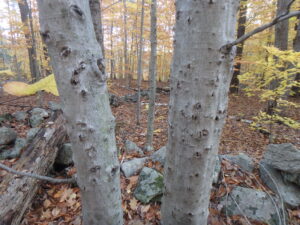If you have cleaned up the vegetable garden and cut back your perennials, you might be feeling just a little smug – especially since this gardening guy admits he is behind you in completing those tasks. But there may still be tasks for you to do, and important ones for the trees on your property.
Are you one of those gardeners who has fallen in love with bark mulch? Do you use it not only in flower gardens, but also around trees planted in the lawn to keep down weeds, hold in moisture, and keep the deadly string trimmer at bay? If you do, take a few moments to walk around and check out your trees and shrubs.
Bark mulch should never touch the stems of woody plants. You need a donut hole around your trees: a 4-to 6-inch area bare of mulch on all sides of your beloved trees. Why? Tree barks protects the tree from rain and snow, but it will eventually rot if it is covered with soil or bark mulch. And if the rot extends into the cambium layer – the layer beneath the bark – it will, eventually, kill the tree. But mulch is not the only culprit. Many trees are planted too deeply and the flare is covered with soil, which is just as lethal.
If you look at a tree that Mother Nature planted – or perhaps it was a forgetful squirrel – you will see that tree flares or widens at its base. That part of the tree needs to be planted above ground at planting time. Unfortunately, trees sold in pots often have the trunk flare covered with soil and get planted just the way they were in the pot. I have seen trees in large pots with the trunk flare covered by 4 inches of soil or more.
Mulch or soil over the trunk flare does not kill your tree right away. It often takes from six to ten years to see signs of decline. Look at the tips of branches at the top of the tree. Leaf loss there is a definite sign of decline. Early color change in the fall is another sign. That maple that turns color before others on the property? It may be stressed by bark rot caused by damage to the trunk flare.
So examine your trees. If the trunk flare is covered with mulch or soil, you have work to do. If a tree is straight (like a telephone pole) at the soil surface, you need to pull the mulch away. And if you still don’t see a flared area, you need to re-grade the soil around your tree.
Use gloved hands or work gently with a hand tool to remove the soil around the tree until you see the trunk flare. You may notice fine roots in the soil or mulch as you remove it, but these roots can be cut away. You are looking for big roots headed away from the trunk. Keep your hand tool away from the trunk as the bark will be tender, and easily damaged. But the good news is that most trees will recover if you remove the soil or bark mulch and let the bark dry out.
If you have planted a tree on a hillside, I assume you planted it be vertical. But to do that you had to cut back into the uphill side of the planting area to create a flat spot. If, after planting, erosion has moved soil downhill to cover one side of the trunk, remove that. People with excavators working on your property presumably know not to pile soil against the bark of trees, but check anyway. Remove soil as needed.

These beeches are infected with a fungus that will prove fatal in time
Another fall task involves protecting young trees from damage by rodents. The worst is the meadow vole. These are little rodents that look a lot like mice – but stockier, with short tails. Think of mice as a ballerinas and voles as hockey players. They often leave tunnels in the lawn grass during the winter.
Voles can reach sexual maturity in just 5 weeks after birth, so they can increase in numbers exponentially, given the right conditions. If hungry enough, they will chew the bark off young trees, killing them by damaging the tender cambium layer and eating the phloem all around a tree, girdling it.
Young fruit trees are the most susceptible to girdling. Older trees have thicker bark, and are generally less interesting to rodents. If you planted an apple tree within the last five years, you should protect the bark. Even though they did not damage the tree in the past, you cannot assume they will not this year. If there are high numbers of voles this year, and a deep snow cover to hide them from predators, they may attack.
The best way to protect trees against damage by voles is to surround the trunk with a ring of wire mesh called hardware cloth. Get some with quarter-inch spacing of the wires, and create a ring 24-inches tall. Make the ring of wire big enough to leave a couple of inches of space between the mesh and the trunk. That will allow the tree to get fatter without meeting the hardware cloth. If you have low branches (within 24 inches of the ground), you can prune them off to accommodate the wire mesh.
Hardware cloth comes in 24 inch rolls. You will need tin snips to cut it and leather gloves to protect your fingers. The stuff is like razor wire once cut. But, having seen what rodents can do, I recommend protecting new trees. There are plastic wraps and special cloth wraps that claim to protect against rodents, and may, but I have not tried them. They are definitely easier to use. So check out your trees, and get busy if need be.



